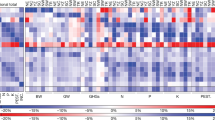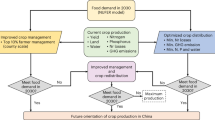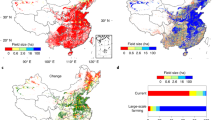Abstract
China is experiencing rapid land-use change and shifts in farm management. However, the interactive effects of these drivers on cropping system sustainability are unclear. Here, we evaluate spatio-temporal trade-offs among crop production and five key environmental indicators, including land use, water consumption, excess nitrogen and phosphorous use, and greenhouse gas emissions in China. From 1987 to 2010, as crop kilocalorie production increased (+66%), so did the total environmental impact of all indicators (+1.3–161%) except greenhouse gas emissions (−18%). Concurrently, environmental intensity—impact per kilocalorie produced—decreased for all indicators (−51–−13%) except excess phosphorus (+57%). Despite substantial loss and displacement of cropland to urban expansion, counterfactual scenario analysis indicates that farm management explained >90% of changes in crop production and environmental impact. However, cropland is expanding in regions of relatively high land and irrigation intensity. Although efficiency gains partly compensated for increased environmental pressures, continued geographic shifts in cropland could challenge progress towards agricultural sustainability in China.
This is a preview of subscription content, access via your institution
Access options
Access Nature and 54 other Nature Portfolio journals
Get Nature+, our best-value online-access subscription
$29.99 / 30 days
cancel any time
Subscribe to this journal
Receive 12 digital issues and online access to articles
$119.00 per year
only $9.92 per issue
Buy this article
- Purchase on Springer Link
- Instant access to full article PDF
Prices may be subject to local taxes which are calculated during checkout




Similar content being viewed by others
References
World Population Prospects: The 2017 Revision, DVD edn (United Nations Department of Economic and Social Affairs, Population Division, 2017).
FAOSTAT: FAOSTAT Online Statistical Service (Food and Agriculture Organization, 2017); http://www.fao.org/faostat/en/#data
Seto, K. C. & Ramankutty, N. Hidden linkages between urbanization and food systems. Science 352, 943–945 (2016).
OECD-FAO Agricultural Outlook 2013 (Organisation for Economic Cooperation and Development and the Food and Agriculture Organization, 2013).
Liu, G., Liu, X. & Cheng, S. Food security: curb China’s rising food wastage. Nature 498, 170–170 (2013).
National Data: Online Statistical Service (National Bureau of Statistics of the People’s Republic of China 2017); http://data.stats.gov.cn/index.htm
Liu, J. et al. Spatiotemporal characteristics, patterns, and causes of land-use changes in China since the late 1980s. J. Geogr. Sci. 24, 195–210 (2014).
Yan, H., Liu, J., Huang, H. Q., Tao, B. & Cao, M. Assessing the consequence of land use change on agricultural productivity in China. Glob. Planet. Change 67, 13–19 (2009).
Du, T., Kang, S., Zhang, X. & Zhang, J. China’s food security is threatened by the unsustainable use of water resources in North and Northwest China. Food Energy Secur. 3, 7–18 (2014).
Huang, J., Xu, C. C., Ridoutt, B. G., Wang, X. C. & Ren, P. A. Nitrogen and phosphorus losses and eutrophication potential associated with fertilizer application to cropland in China. J. Clean. Prod. 159, 171–179 (2017).
Lu, C. & Tian, H. Net greenhouse gas balance in response to nitrogen enrichment: perspectives from a coupled biogeochemical model. Glob. Change Biol. 19, 571–588 (2013).
West, P. C. et al. Leverage points for improving global food security and the environment. Science 345, 325–328 (2014).
Garnett, T. et al. Sustainable intensification in agriculture: premises and policies. Science 341, 33–34 (2013).
Lu, Y. et al. Addressing China’s grand challenge of achieving food security while ensuring environmental sustainability. Sci. Adv. 1, e1400039 (2015).
Cui, K. & Shoemaker, S. P. A look at food security in China. NPJ Sci. Food 2, 4 (2018).
Sun, W. & Huang, Y. Synthetic fertilizer management for China’s cereal crops has reduced N2O emissions since the early 2000s. Environ. Pollut. 160, 24–27 (2012).
Cui, Z. et al. Pursuing sustainable productivity with millions of smallholder farmers. Nature 555, 363–366 (2018).
Annual Report on Forestry Statistics in China: 2014 (in Chinese) (State Forestry Bureau, 2014); http://www.forestry.gov.cn/main/225/content-763186.html
Ghose, B. Food security and food self-sufficiency in China: from past to 2050. Food Energy Secur. 3, 86–95 (2014).
Erb, K.-H. et al. Exploring the biophysical option space for feeding the world without deforestation. Nat. Commun. 7, 11382 (2016).
Bren d'Amour, C. et al. Future urban land expansion and implications for global croplands. Proc. Natl Acad. Sci. USA 114, 8939–8944 (2016).
Zhang, F., Chen, X. & Vitousek, P. Chinese agriculture: an experiment for the world. Nature 497, 33–35 (2013).
Zhang, X. et al. Managing nitrogen for sustainable development. Nature 528, 51–59 (2015).
Kang, S. et al. Improving agricultural water productivity to ensure food security in China under changing environment: from research to practice. Agric. Water Manag. 179, 5–17 (2017).
Brauman, K. A., Siebert, S. & Foley, J. A. Improvements in crop water productivity increase water sustainability and food security—a global analysis. Environ. Res. Lett. 8, 024030 (2013).
Carlson, K. M. et al. Greenhouse gas emissions intensity of global croplands. Nat. Clim. Change 7, 63–68 (2016).
Clark, M. & Tilman, D. Comparative analysis of environmental impacts of agricultural production systems, agricultural input efficiency, and food choice. Environ. Res. Lett. 12, 064016 (2017).
Zhu, L. & Liu, Y. Analysis of the impact of off-farm employment of agricultural labor on grain production in Shandong Province and Henan Province. Agric. Sci. Technol. 13, 1609–1615 (2012).
Brauman, K. A., Richter, B. D., Postel, S., Malsy, M. & Flörke, M. Water depletion: an improved metric for incorporating seasonal and dry-year water scarcity into water risk assessments. Elementa 4, 000083 (2016).
Sui, X. Analysis on Spatial Patterns on Fertilizer Application and its Impacts on Crop Production in China. PhD thesis, China Agricultural Univ. (2007).
Zhang, W., Yu, Y., Huang, Y., Li, T. & Wang, P. Modeling methane emissions from irrigated rice cultivation in China from 1960 to 2050. Glob. Change Biol. 17, 3511–3523 (2011).
Fang, J., Chen, A., Peng, C., Zhao, S. & Ci, L. Changes in forest biomass carbon storage in China between 1949 and 1998. Science 292, 2320–2322 (2001).
Deng, L. et al. Past and future carbon sequestration benefits of China’s grain for green program. Glob. Environ. Change 47, 13–20 (2017).
Gilles, B., Luis, L. & Josette, G. A vast range of opportunities for feeding the world in 2050: trade-off between diet, N contamination and international trade. Environ. Res. Lett. 10, 025001 (2015).
Jiang, Y. et al. Higher yields and lower methane emissions with new rice cultivars. Glob. Change Biol. 00, 1–11 (2017).
Lassaletta, L., Billen, G., Grizzetti, B., Anglade, J. & Garnier, J. 50 year trends in nitrogen use efficiency of world cropping systems: the relationship between yield and nitrogen input to cropland. Environ. Res. Lett. 9, 105011 (2014).
Lun, F., Liu, J. & Zhang, D. Trends in cropland P balance and P use efficiency in China from 1961 to 2011 (in Chinese). Resour. Sci. 38, 1681–1691 (2016).
Mueller, N. D. et al. A tradeoff frontier for global nitrogen use and cereal production. Environ. Res. Lett. 9, 054002 (2014).
IFADATA (International Fertilizer Association, 2017); http://ifadata.fertilizer.org/ucSearch.aspx
Cassman, K. G., Dobermann, A. W. D. T. & Yang, H. Meeting cereal demand while protecting natural resources and improving environmental quality. Annu. Rev. Environ. Resour. 28, 315–358 (2003).
Zhang, H., Xu, F., Wu, Y., Hu, H. H. & Dai, X. F. Progress of potato staple food research and industry development in China. J. Integr. Agric. 16, 2924–2932 (2017).
Li, J., Deng, X. & Seto, K. C. The impact of urban expansion on agricultural land use intensity in China. Land Use Policy 35, 33–39 (2013).
Distribution Patterns on Reserved Arable Land in China (Ministry of Land and Resources of the People’s Republic of China, 2016); http://www.mlr.gov.cn/wszb/2016/gd/zhibozhaiyao/201612/t20161228_1425472.htm
Zuo, L. et al. Multitemporal analysis of cropland transition in a climate-sensitive area: a case study of the arid and semiarid region of northwest China. Reg. Environ. Change 14, 75–89 (2014).
Zuo, L., Wang, X., Liu, F. & Yi, L. Spatial exploration of multiple cropping efficiency in China based on time series remote sensing data and econometric model. J. Integr. Agric. 12, 903–913 (2013).
Ye, L. et al. Climate change impact on China food security in 2050. Agron. Sustain. Dev. 33, 363–374 (2013).
Trimmer, J. T., Cusick, R. D., & Guest, J. S. Amplifying progress toward multiple development goals through resource recovery from sanitation. Environ. Sci. Technol. 51, 10765–10776 (2017).
Zhang, Z. et al. A 2010 update of National Land Use/Cover Database of China at 1:100000 scale using medium spatial resolution satellite images. Remote Sens. Environ. 149, 142–154 (2014).
Siebert, S. & Döll, P. Quantifying blue and green virtual water contents in global crop production as well as potential production losses without irrigation. J. Hydrol. 384, 198–217 (2010).
IPCC 2006 IPCC Guidelines for National Greenhouse Gas Inventories (IGES, 2006).
AgriData (Chinese Academy of Agricultural Sciences, 2014); http://www.agridata.cn/default.aspx
Monfreda, C., Ramankutty, N. & Foley, J. A. Farming the planet: 2. Geographic distribution of crop areas, yields, physiological types, and net primary production in the year 2000. Glob. Biogeochem. Cycles 22, 89–102 (2008).
Fertilizer Use by Crop (IFA, IFDC, IPI, PPI & FAO, 2002).
Heffer, P. Assessment of Fertilizer Use by Crop at the Global Level, Annex 1–8 (International Fertilizer Industry Association, 2009).
Li, H., Zhang, W., Zhang, F., Du, F. & Li, L. Chemical fertilizer use and efficiency change of main grain crops in China (in Chinese). Plant Nutr. Fertil. Sci. 16, 1136–1143 (2010).
Zhang, W. & Zhang, F. The Development of Fertilizer in China (in Chinese) (China Agricultural Univ. Press, Beijing, 2012)
Mueller, N. D. et al. Closing yield gap through nutrient and water management. Nature 490, 254–257 (2012).
Smil, V. Nitrogen in crop production: An account of global flows. Glob. Biogeochem. Cycles 13, 647–662 (1999).
Dentener, F. et al. Nitrogen and sulfur deposition on regional and global scales: A multimodel evaluation. Glob. Biogeochem. Cycles 20, 16615–16615 (2006).
Liu, X. et al. Enhanced nitrogen deposition over China. Nature 494, 459–462 (2013).
Agricultural Waste Field Management Handbook, Vol. NEH-651 (US Department of Agriculture, Washington DC, 1999).
Myhre, G. et al. in Climate Change 2013: The Physical Science Basis (eds Stocker, T. F. et al.) 714 (IPCC, Cambridge Univ. Press, 2013).
Butterbach-Bahl, K., Baggs, E. M., Dannenmann, M., Kiese, R. & Zechmeister-Boltenstern, S. Nitrous oxide emissions from soils: how well do we understand the processes and their controls?. Phil. Trans. R. Soc. Lond. 368, 122–134 (2013).
Gerber, J. S. et al. Spatially explicit estimates of N2O emissions from croplands suggest climate mitigation opportunities from improved fertilizer management. Glob. Change Biol. 22, 3383–3394 (2016).
Shi, X. Z. et al. Soil database of 1:1,000,000 digital soil survey and reference system of the Chinese Genetic Soil Classification System. Soil Surv. Horiz. 45, 129–136 (2004).
IPCC 2013 Supplement to the 2006 IPCC Guidelines for National Greenhouse Gas Inventories: Wetlands (IPCC, 2013).
Zhang, X. 1:1,000,000 Vegetation Map In China (in Chinese) (Geological Press, 2007).
National Fundamental Geographic Database (National Geomatics Center of China, National Administration of Surveying, Mapping and Geoinformation, 1998).
Harmonized World Soil Database (version 1.2) (FAO and IIASA, 2012).
Climatic Zone Layer (European Soil Portal, European Commission Joint Research Centre); http://eusoils.jrc.ec.europa.eu/projects/RenewableEnergy/
Hansis, E., Davis, S. J. & Pongratz, J. Relevance of methodological choices for accounting of land use change carbon fluxes. Glob. Biogeochem. Cycles 29, 1230–1246 (2015).
Acknowledgements
We thank N.D. Mueller from University of California-Irvine for help in developing crop-specific fertilizer application rate dataset. This work benefited from the comments of H. Tian from Auburn University and J. Hellmann from University of Minnesota, Twin Cities. Funding was provided by National Key Research and Development Program of China (No. 2017YFE0104600), National Major Science and Technology Program for Water Pollution Control and Treatment (No. 2017ZX07101001), the Gordon and Betty Moore Foundation, and the Belmont Forum/FACCE-JPI funded DEVIL project (NE/M021327/1). K.M.C. was supported by the USDA National Institute of Food and Agriculture Hatch project HAW01136-H managed by the College of Tropical Agriculture and Human Resource. G.K.M. was supported by the Natural Sciences and Engineering Research Council of Canada (NSERC).
Author information
Authors and Affiliations
Contributions
L.Z., Z.Z., P.C.W. and J.S.G. designed the study. L.Z., Z.Z., Y.L., W.Z., W.W., X.Z., X.W., B.L., L.Y., Q.W., F.L., J.X., S.H., F.S., K.M.C. and K.A.B. prepared the data and/or carried out modelling. L.Z., Z.Z., K.M.C., G.K.M., K.A.B. and H.Z. analysed the data. L.Z., K.M.C., G.K.M., K.A.B., P.C.W. and J.S.G. wrote the paper.
Corresponding author
Ethics declarations
The authors declare no competing interests.
Additional information
Publisher’s note: Springer Nature remains neutral with regard to jurisdictional claims in published maps and institutional affiliations.
Supplementary information
Supplementary Information
Supplementary Figures 1-10, Supplementary Tables 1-13, Supplementary Methods, Supplementary References 1-35
Supplementary Dataset 1
Crop-specific production and environmental impacts for each indicator and each year
Supplementary Dataset 2
Ratio of crops planted in main season in each province for each period
Supplementary Dataset 3
Crop-specific nutrient application rates
Supplementary Dataset 4
Irrigation rate for each crop in each province
Supplementary Dataset 5
Ratio of irrigated crops planted in main season in each province for each period
Rights and permissions
About this article
Cite this article
Zuo, L., Zhang, Z., Carlson, K.M. et al. Progress towards sustainable intensification in China challenged by land-use change. Nat Sustain 1, 304–313 (2018). https://doi.org/10.1038/s41893-018-0076-2
Received:
Accepted:
Published:
Issue Date:
DOI: https://doi.org/10.1038/s41893-018-0076-2
This article is cited by
-
Coupling Coordination Analysis of Cropland Intensification and Agroecosystem Services: Evidence from Loess Plateau in Shaanxi Province, China
Chinese Geographical Science (2024)
-
Spatiotemporal patterns and evolutionary trends of eco-environmental quality in arid regions of Northwest China
Environmental Monitoring and Assessment (2024)
-
Trade-offs between economic benefits and environmental impacts in non-grain expansion: a case study in the eastern plain of China
Environmental Science and Pollution Research (2024)
-
Research progress in assessment and strategies for sustainable food system within planetary boundaries
Science China Earth Sciences (2024)
-
Insights into long-term changes of groundwater levels in the typical region of Zhangjiakou City, China
Environmental Science and Pollution Research (2023)



